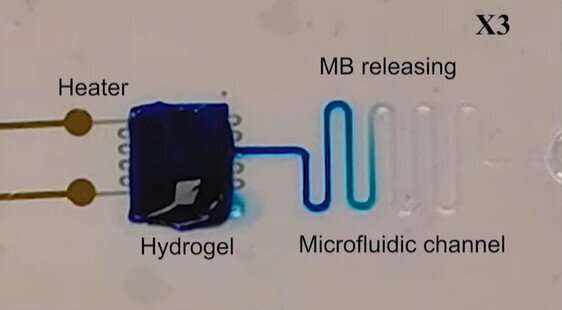An artificial neuron that can receive and release dopamine

A team of researchers from Nanjing University of Posts and Telecommunications and the Chinese Academy of Sciences in China and Nanyang Technological University and the Agency for Science Technology and Research in Singapore developed an artificial neuron that is able to communicate using the neurotransmitter dopamine. They published their creation and expected uses for it in the journal Nature Electronics.
As the researchers note, most machine-brain interfaces rely on electrical signals as a communications medium, and those signals are generally one-way. Electrical signals generated by the brain are read and interpreted; signals are not sent to the brain. In this new effort, the researchers have taken a step toward making a brain-machine interface that can communicate in both directions, and it is not based on electrical signals. Instead, it is chemically mediated.
The work involved building an artificial neuron that could both detect the presence of dopamine and also produce dopamine as a response mechanism. The neuron is made of graphene (a single sheet of carbon atoms) and a carbon nanotube electrode (a single sheet of carbon atoms rolled up into a tube). They then added a sensor capable of detecting the presence of dopamine and a device called a memristor that is capable of releasing dopamine using a heat-activated hydrogel, attached to another part of their artificial neuron.
The researchers tested the ability of their artificial neuron to communicate by placing it in a petri dish with some brain cells collected from a rat. They found it was able sense and respond to dopamine created and sent by the rat brain cells and also to produce some of its own, which then produced a response in the rat brain cells. They also found that they could activate a small mouse muscle sample by sending dopamine to a sciatic nerve, which was used to move a robot hand.
The researchers note that the memristor can be programmed to generate and send different amounts of dopamine depending on the application, just as brain cells do. They acknowledge that their setup is quite bulky, which would limit its use as a brain-machine interface, but note that it might be usable in its current form in a prosthetic device.
Ting Wang et al, A chemically mediated artificial neuron, Nature Electronics (2022). DOI: 10.1038/s41928-022-00803-0
© 2022 Science X Network
Citation:
An artificial neuron that can receive and release dopamine (2022, August 9)
retrieved 9 August 2022
from https://techxplore.com/news/2022-08-artificial-neuron-dopamine.html
This document is subject to copyright. Apart from any fair dealing for the purpose of private study or research, no
part may be reproduced without the written permission. The content is provided for information purposes only.
For all the latest Technology News Click Here
For the latest news and updates, follow us on Google News.
